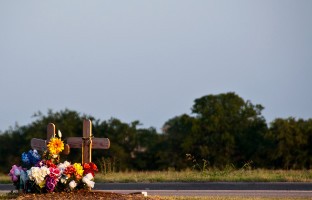Roadside crosses: Personal shrines in public places
"You'd think they'd want to remember the person in connection with something other than the accident," a friend suggested. We had just driven past a small cross, decorated with artificial flowers, set in the tangle beyond a guardrail. We presumed it meant that someone had lost his or her life in a crash by that place. Why memorials like this were becoming more common was something that made us wonder.
Like me, my friend accepts the old custom of a church funeral and a marker in a cemetery. Though we had scattered a family member's ashes in accordance with his wishes, we had also erected a stone next to that of his parents. But we weren't sure what to make of the roadside cross.
I was reminded of those scenes in cowboy movies in which the survivors of some deadly encounter bury their dead. People are buried where they fall. A handmade cross is raised along the trail, and the mourners saddle up and ride on. In the wilderness, it's understood that graves must be convenient and observances simple. Civilization's instincts are present, but there is no settled place, no apparatus of established religion and community cemetery.





